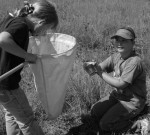“In the last five years students in our SLTER Fall Grasshopper Inventory have added six species to the Konza Prairie grasshopper list,” says Valerie Wright, Environmental Educator/Naturalist, Konza Prairie LTER.
Grasses typify the Great Plains, so it’s not surprising that more than 108 species of grasshoppers are at home on the range in the central United States. However, a grasshopper that doesn’t love grass lives in Kansas too, a recent discovery at Kansas State University’s Konza Prairie Biological Station shows. This newfound hopper prefers trees.
The first specimen was actually collected in September 2001 by a student from Fort Riley Middle School, according to Valerie Wright, Konza’s environmental educator and naturalist. However, it wasn’t at first recognized as a new species for the Konza Prairie list, she said. The student collected the insect as part of an ongoing ecological study of grasshopper diversity on Konza called "Schoolyard LTER," a program funded by the National Science Foundation. Every fall elementary, middle school and high school classes come to Konza to inventory the grasshoppers.
The rare tree-dweller has now been positively identified as the Grizzly Spur-throated Grasshopper. Ted Hopkins, retired K-State entomology professor, longtime grasshopper researcher and Konza Prairie volunteer docent, made the identification. "This appears to be the first recorded sighting of the Grizzly Grasshopper in the Flint Hills region of Kansas," Hopkins said. He discovered two large, dark-colored female hoppers basking in the sun on the stone wall of the old ranch house at Konza in mid-October 2002. Wright, also an entomologist, subsequently collected five males and females from Hackberry tree trunks in October 2003.
Melanoplus punctualatus, the Grizzly Spur-throated Grasshopper, was first identified in the United States in 1862 by an entomologist named Scudder, who specialized in grasshopper identification studies. The Grizzly has preferred eastern hardwood forests and the pine forests of the southeastern region of the country. The species has been reported twice before in Kansas, in Onaga and Oswego, both eastern locations where trees abound. Hopkins verified the specimens in a search of K-State’s extensive entomology collection. "Its discovery on Konza is a big surprise," Hopkins said. Plans are to begin in-depth research on the Grizzly’s lifecycle and habitat for the first time, just as soon as the insects emerge this summer.
Writing in the Spring 2004 issue of "Tallgrass Gazette," the newsletter for Konza Prairie docents, Hopkins said: “The Grizzly grasshopper is a rather unique grasshopper that spends most of its life in trees and is seldom observed because of it secretive habits. It occurs in very low numbers, and that makes it more difficult to determine its habitat." He speculates that its potential distribution on Konza will be limited to wooded areas along creeks and to trees around the headquarters and the Hokanson Homestead.
The Grizzly is a relatively large, very slow moving insect, and given its protective coloration -- medium-gray speckled with dark dots, sometimes with yellowish and whitish areas -- it disappears against the lichen-covered tree bark. Hopkins plans to begin his research observation near the Hackberry trees where the hoppers were last seen. "I’ll be watching for tiny first-stage grasshoppers that hatch from the eggs in late spring and I will observe their development to adulthood," he said. Grasshoppers typically go through five molting stages before becoming adults. Later in the fall, he’ll try to collect enough adult specimens to determine food source and feeding habits.
Hopkins says though so little is known about this insect, it’s likely the Grizzly Spur-throated Grasshopper has been in Kansas "as long as there have been trees."
This story appeared originally in Tallgrass Gazette, a newsletter of the Konza Environmental Education Program (KEEP) at Konza LTER. The story subsequently was carried by the Washington Times courtesy of United Press International, which picked it up from a Kansas State University press release. KSU media had seen the story in Tallgrass Gazette and issued the release. The story was also carried by sciencedaily.com.

 Enlarge this image
Enlarge this image
